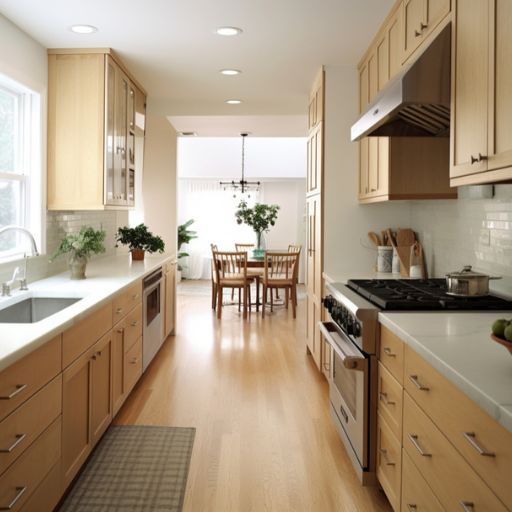 Imagine transforming a dated, uninspiring sideboard into the centerpiece of your cooking haven.
Imagine transforming a dated, uninspiring sideboard into the centerpiece of your cooking haven.
This isn't merely a makeover; it's a commitment to sustainability, as eco-friendly plywood infuses style and consciousness into your kitchen sideboard cabinet, bringing a sense of purpose and elegance.
Witness the change today.
Creating a Sustainable, Stylish Kitchen
An eco-friendly kitchen sideboard cabinet exemplifies modern style, paired with a sustainable consciousness that sets a new standard for home interiors.
This approach relies on utilizing eco-friendly materials like plywood to create a visually appealing kitchen, ensuring that environmental impact is minimal. Such materials also possess the durability and aesthetic versatility needed to elevate a kitchen’s vibrancy while adhering to sustainable practices.
Furthermore, selecting eco-friendly plywood is a mindful choice for those wanting to reduce their carbon footprint. It harmonizes with other kitchen elements, making the entire space feel cohesive and purpose-driven while radiating a sense of sophisticated simplicity.
By adopting these sustainable materials, homeowners can achieve an effortlessly chic kitchen sideboard cabinet that supports eco-conscious living. This commitment not only enhances the home's interior but also contributes positively to a better, greener world, thereby perpetuating a cycle of responsible consumer habits.
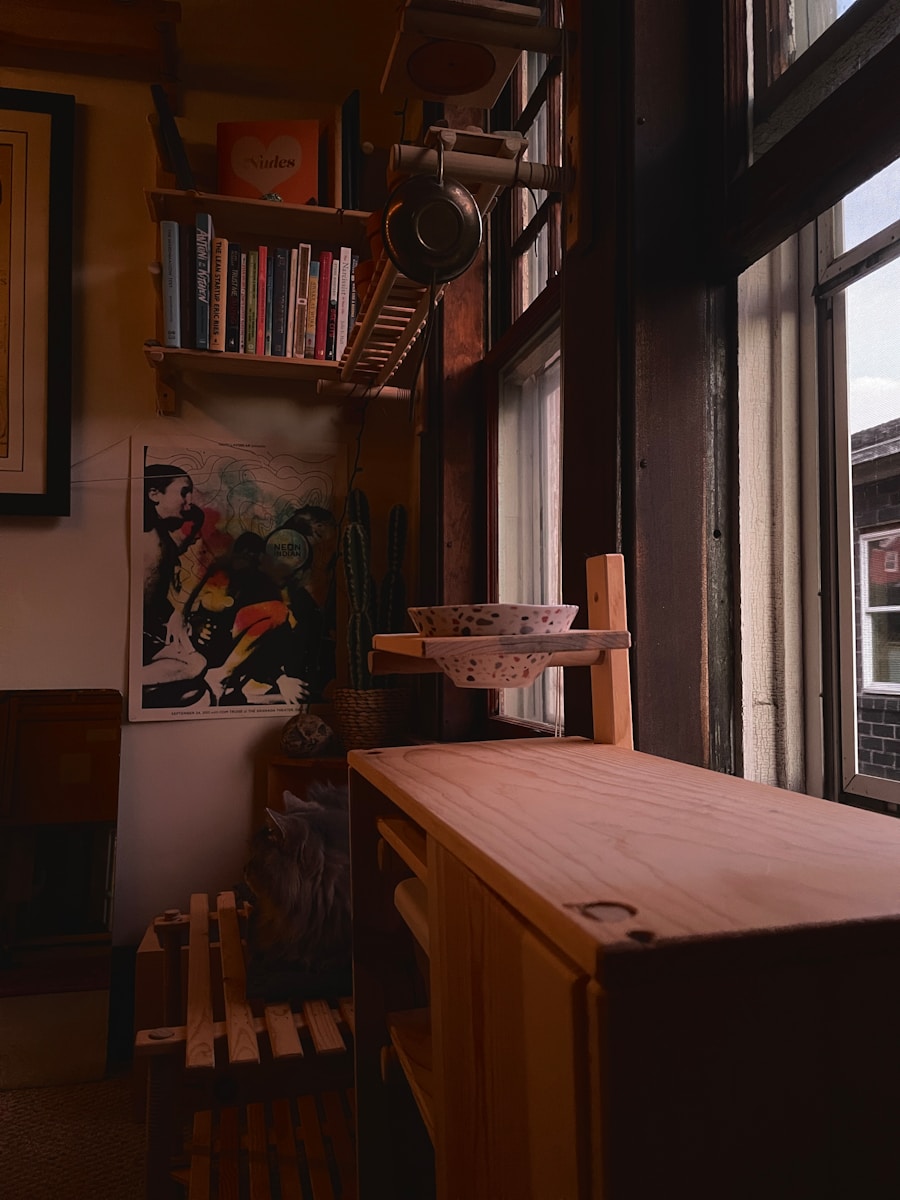
Understanding the Benefits of Eco-Friendly Plywood
Eco-friendly plywood offers numerous advantages for the conscientious homeowner aiming to create a sustainable kitchen space. Its production, obtained from renewable sources, reduces the strain on forests.
Additionally, this material emits lower levels of formaldehyde, making indoor air safer. The health benefits of choosing eco-friendly plywood are thus significant and immediate.
Durability and strength of eco-friendly plywood ensure that kitchen sideboard cabinets retain their functionality and aesthetic appeal for years. This longevity minimizes waste, aligning with long-term sustainable values and responsible living practices.
Ultimately, selecting eco-friendly plywood is a choice imbued with the power to transform home interiors and the environment. This conscious decision results in elegant, lasting kitchen designs that are both sophisticated and harmonious with an eco-friendly lifestyle, fostering an inspiring narrative of conscientious consumption and environmental stewardship.
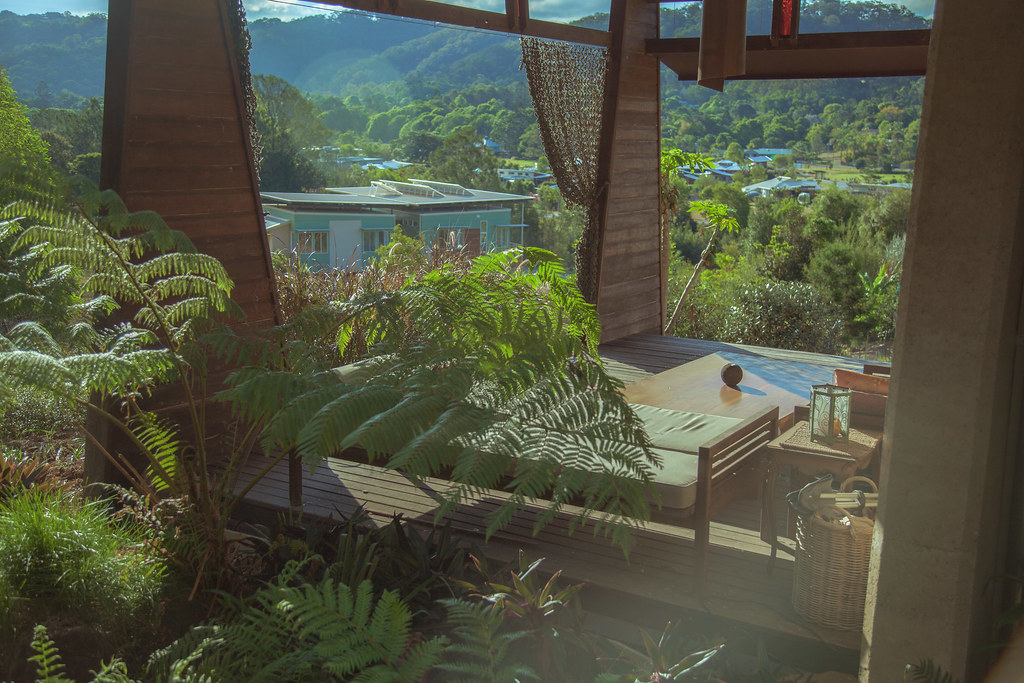
How Plywood Contributes to a Sustainable Home
Eco-friendly plywood transforms kitchen interiors.
Opting for eco-friendly plywood helps minimize one's carbon footprint. This material's production relies on renewable resources, reducing deforestation and habitat destruction, significantly benefiting the environment. Consequently, making it a choice not only sustainable but also emblematic of responsible living.
Eco-plywood safeguards indoor air quality.
Choosing this advanced material means supporting practices that ensure longevity. Its durability and resilience mean less frequent replacements, reducing the overall demand for new materials.
Furthermore, the stylish appearance of plywood aligns seamlessly with the sophisticated needs of modern kitchen designs. They inspire confidence in homeowners aiming to uphold a sustainable lifestyle while maintaining elegance and functionality. By incorporating plywood into kitchen sideboard cabinets and other home fixtures, they contribute toward a green, sustainable future.
Versatile Design Options with Plywood

Plywood, revered for its stunning versatility, seamlessly integrates into contemporary kitchens, enhancing their aesthetic and functionality.
In terms of style, this exceptional material innovatively supports a myriad of design variations (e.g., finishes and textures) to accommodate diverse preferences. Whether choosing sleek, minimalist lines or intricate, classic motifs, plywood shines as the go-to option.
Both “eco-friendly” and “multi-functional” encapsulate plywood's essence within the realm of sustainable kitchen interiors.
Staining and Painting Plywood
Staining and painting plywood dramatically elevate its appearance, creating not only a beautiful kitchen sideboard cabinet but also an eco-conscious environment.
Prepare the surface by sanding and cleaning it. Use a “stain conditioner” to ensure even absorption. This step is crucial for a polished and professional look.
Plywood's high durability and versatility make it an excellent choice for custom kitchen projects.
Choose the appropriate type of paint or stain suited for the intended use. High-quality finishes offer added protection against wear and prolong the life of the kitchen sideboard cabinet. Sustainable options further the commitment to eco-friendly living while elevating kitchen aesthetics.
Using Natural Plywood Finishes

Natural plywood finishes offer an exquisite combination of beauty, sustainability, and durability. They instill a harmonious ambiance in the kitchen.
These finishes enhance the grain, adding warmth and character. Each piece is unique.
Opting for natural finishes reduces harmful chemical emissions. It supports a healthier kitchen environment while maintaining an elegant touch.
This eco-friendly choice allows the beauty of plywood to shine through, making it an ideal option for a stunning kitchen sideboard cabinet. By choosing natural finishes, homeowners contribute to sustainability, linking personal well-being with global environmental responsibility. The result is a kitchen that’s not just functional but also inspires and delights.
Sustainability of Plywood: An Eco-Friendly Choice
Plywood stands as a robust, sustainable option, embodying the virtues of eco-friendly living and conscientious consumption.
Its production demands less energy compared to other materials, and it employs wood veneers from fast-growing trees, making it a renewable resource. These factors collectively reduce the carbon footprint associated with manufacturing, promoting a greener planet.
Its durability ensures longevity, reducing the frequency of replacements and thus the demand for additional resources. This resilience translates into fewer trees being cut down over time, further preserving global forests.
With its low environmental impact and sustainable harvesting methods, plywood supports ecosystem conservation. Its adoption in kitchen sideboard cabinet construction exemplifies a commitment to sustainability, offering a beautiful, functional solution that uplifts both the household and the planet. It reassures homeowners that their choices genuinely make a difference, fostering a legacy of environmental stewardship.
Combining Plywood with Other Eco-Friendly Materials
Plywood harmonizes with diverse, eco-conscious substances seamlessly.
Pairing it with reclaimed wood creates an authentic, rustic charm. Not only does this infuse a distinct character into kitchen sideboard cabinets, but it also preserves valuable resources. Additionally, utilizing bamboo accents can enhance the aesthetic appeal while contributing to sustainable material usage, owing to bamboo's rapid growth cycle.
Cork is another exemplary material.
It offers insulation properties and is harvested without damaging the tree, making it an impeccable addition. By integrating these holistic materials, designers can craft sideboards that are not only beautiful but also environmentally responsible.
Consumers are increasingly prioritizing sustainable combinations, recognizing the broader environmental benefits. Integrating eco-friendly materials like plywood, reclaimed wood, bamboo, and cork contribute significantly to sustainable living, cultivate a sense of pride in eco-friendly choices, and inspire others to follow suit.
Sustainable Materials in Modern Kitchens
Integrating sustainable materials in modern kitchens has become a defining element of environmentally conscious design. Plywood, for instance, is a versatile material that signifies a commitment to reducing waste.
Reclaimed wood is another standout choice for a kitchen sideboard cabinet.
It brings an unparalleled rustic aesthetic that denotes a conscious effort to conserve natural resources.
Bamboo's rapid growth makes it an ideal sustainable choice for various kitchen applications.
One must not overlook cork, which offers exceptional insulation properties and is harvested without harm to the tree.
Consumers increasingly prefer these sustainable materials for their kitchens. This growing trend reflects an optimistic shift towards creating beautiful, eco-friendly spaces.
Plywood vs. Solid Wood: Cost and Benefits
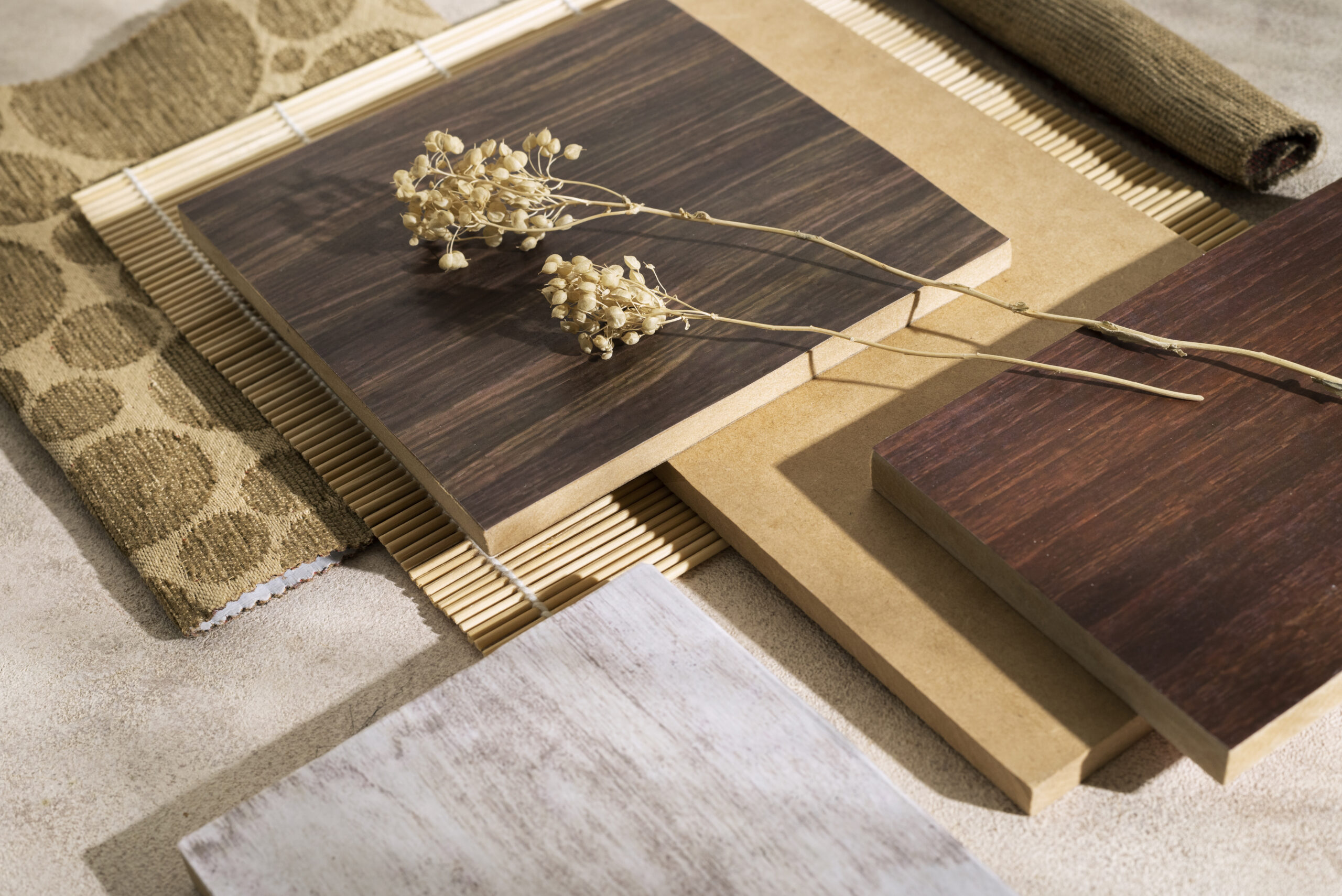
Choosing between plywood and solid wood for kitchen sideboard cabinets depends largely on cost considerations, aesthetic appeal, and the functional benefits each material offers.
Plywood generally costs less than solid wood.
In contrast, solid wood typically has higher upfront costs but offers enhanced durability.
Plywood is composed of thin layers of wood veneers, which makes it resistant to warping.
This structural integrity can be a significant advantage in kitchens where moisture levels fluctuate.
Conversely, solid wood, with its unique grain patterns, provides unmatched beauty and a sense of timeless quality that many homeowners cherish.
Ultimately, the choice between plywood and solid wood hinges on individual priorities. Opting for plywood emphasizes a budget-friendly, sustainable approach, while solid wood underscores a commitment to durability and classic aesthetics.
AmpQuartz: Leading the Way in Eco-Friendly Surfaces
AmpQuartz is revolutionizing kitchen design with its eco-friendly surfaces, which combine beauty, sustainability, and functionality. These innovative surfaces have garnered widespread acclaim and resonate with environmentally conscious homeowners.
With AmpQuartz, kitchen sideboard cabinets gain an eco-friendly edge. AmpQuartz advances sustainable solutions.
By leveraging recycled materials, AmpQuartz offers countertops and surfaces that reduce environmental impact. These surfaces not only meet aesthetic standards but also promote eco-conscious living.
AmpQuartz's commitment to sustainability extends beyond materials. Their manufacturing process emphasizes reduced waste and energy efficiency. This approach underscores their dedication to a greener future.
Their products are certified by various environmental organizations, affirming their adherence to stringent eco-friendly standards. Homeowners are empowered to make choices that align with their environmental values.
AmpQuartz stands as a beacon of innovation and sustainability. Their products reflect an unwavering commitment to creating beautiful, eco-friendly spaces while setting industry standards for green practices.
Achieving a Harmonious Blend: Eco-Friendly Materials in Your Kitchen
In today's world, sustainability is crucial in creating a beautiful and functional kitchen.
Since 2016, various initiatives, like those from AmpQuartz, have made eco-friendly materials more accessible. They have tailored their products to meet contemporary demands for sustainability without compromising on style.
Now, homeowners can achieve a harmonious blend in their kitchens by using these eco-friendly materials. Kitchen sideboard cabinets, crafted from sustainable plywood, elegantly marry functionality with environmental responsibility.
When selecting eco-friendly products, consider the source of the materials, the manufacturing process, and certifications. These factors ensure that the chosen materials align with one's commitment to the environment and aesthetic vision.
Incorporating these elements can transform kitchens into spaces of eco-conscious beauty and high functionality.
Benefits of Recycled Materials in Quartz
Recycled materials in quartz offer tremendous environmental benefits. They reduce waste accumulation and promote sustainability, which plays an influential role in preserving natural resources.
Utilizing them reduces the need for virgin materials.
Furthermore, recycled materials in quartz contribute significantly to lowering greenhouse gas emissions, making it a greener option than traditional counterparts.
The decision to incorporate recycled materials in quartz can be a compelling testament to a commitment to the environment, as it demonstrates an earnest effort to minimize ecological footprints. In essence, it aligns not only with environmental ethics but also with contemporary trends toward sustainability.
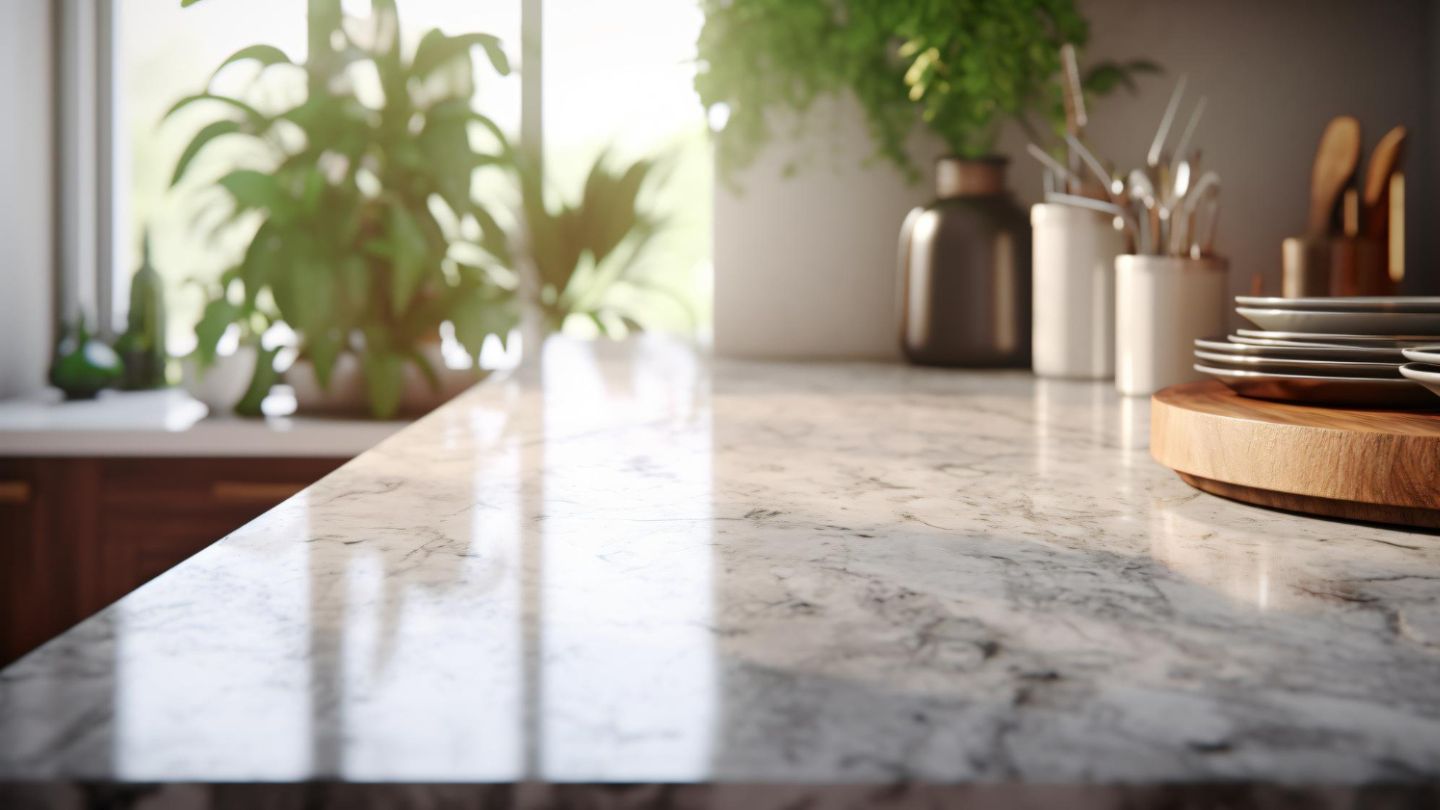
Durability and Longevity of Quartz Surfaces
The inherent strength of quartz surfaces makes them ideal for high-traffic kitchen areas. Their remarkable resistance to scratches, stains, and heat ensures a pristine, long-lasting appearance year after year.
These surfaces also exhibit excellent durability without demanding extensive maintenance, further reinforcing their value as a top choice for a sustainable and practical kitchen sideboard cabinet.
Scratch and Stain Resistance
When it comes to kitchen sideboard cabinets, scratch and stain resistance are paramount.
These features ensure that surfaces maintain their elegance and usability over time.
With expertly engineered coatings and finishes, eco-friendly plywood outperforms expectations, providing a layer of protection against daily wear and tear. This resilience not only ensures lasting beauty but also reduces the need for frequent replacements.
Such exceptional resistance directly translates to fewer resources being utilized in the long run. By choosing materials that offer strength and endurance, they make an investment not just in their kitchen, but in a more sustainable future. This foresight keeps the kitchen sideboard cabinet looking as impeccable as the day it was installed.
Heat Resistance Features
Eco-friendly plywood is distinct in its ability to withstand high temperatures without compromising its structural integrity.
- Advanced Lamination: Provides an additional layer of protection against heat.
- High-Quality Adhesives: Ensure the plywood remains bonded under extreme temperature fluctuations.
- Thermal Insulation: Reinforces the capability to resist heat transfer.
- Durable Coatings: Protect the surface from scorching and warping.
- Sustainable Materials: Natural resins enhance heat resistance while being environmentally friendly.
These elements collectively contribute to an elegant, heat-resilient kitchen sideboard cabinet.
Investing in heat-resistant eco-friendly plywood means fewer worries about damages from hot cookware.
Such durable and stylish features offer peace of mind while enhancing the kitchen’s overall sustainability.
Non-Toxic Quartz for a Healthier Kitchen
In pursuit of a healthier kitchen, homeowners are increasingly turning to non-toxic quartz for countertops and other surfaces.
Non-toxic quartz is engineered to be a resilient, antimicrobial material that does not emit harmful chemicals, making it an excellent choice for those prioritizing health and well-being. Unlike traditional materials, it ensures a clean surface that is resistant to bacteria and microbial growth, elevating the hygiene standards of any kitchen space.
Further reinforcing its benefits, non-toxic quartz offers an exceptional balance of durability and aesthetics. Its non-porous surface prevents stains and spills from seeping in, making maintenance an absolute breeze while maintaining a polished, elegant look.
Additionally, non-toxic quartz embodies an eco-friendly nature, being composed of over 90% natural quartz crystals. Its sustainable production process not only supports environmental conservation but also ensures that the kitchen remains a haven of health and sustainability. Adopting non-toxic quartz for your kitchen sideboard cabinet guarantees an enduring investment in both sophistication and wellness.
Design Versatility of AmpQuartz
AmpQuartz's impressive design versatility, a hallmark of modern architectural solutions, stands out vividly. Their offerings include various textures and hues, harmonizing perfectly with any kitchen décor. This adaptability ensures that AmpQuartz is a focal point in diverse style preferences.
For individuals who seek an elegant and functional kitchen sideboard cabinet, AmpQuartz adds a distinct blend of beauty and durability. The material's innovative adaptability allows it to match any aesthetic, from minimalist to traditional designs.
By integrating AmpQuartz, they are investing in a kitchen that exudes both contemporary flair and timeless class.
Color Options and Patterns
When exploring the potential of an AmpQuartz kitchen sideboard cabinet, the color options available are truly exemplary.
Since 2016, AmpQuartz has curated a diverse palette inspired by nature, offering shades that breathe life into any culinary space, ensuring each kitchen sideboard cabinet exudes a unique character.
From serene whites and cool grays to bold blacks and warm browns, AmpQuartz’s array of hues caters to both conservative and adventurous design personalities, providing flexibility in kitchen styling.
Complementing these colors, they present an exquisite variety of patterns, each adding a touch of sophistication. The intricate veining and subtle textures mimic the elegance of natural stone, making it a captivating choice.
Its harmonious blend of colors and refined patterns transforms every kitchen sideboard cabinet into a bespoke piece, marking a celebration of aesthetic allure and sustainability.
Compatibility with Different Styles
The versatility of eco-friendly plywood opens doors to numerous kitchen design styles.
- Modern Elegance: Clean lines and minimalist aesthetics.
- Rustic Charm: Warm tones and natural grain patterns.
- Industrial Vibe: Bold edges with functional simplicity.
- Traditional Comfort: Classic looks with timeless appeal.
Each style, rich with its unique appeal, finds harmony with eco-friendly plywood.
Eco-friendly plywood offers seamless adaptability, enhancing various existing décor themes effortlessly.

The Resurgence of Plywood in Kitchen Design
Plywood has made a robust comeback.
Once perceived primarily as a utility material, it now enjoys renewed recognition in home interiors. The latest innovations in plywood manufacturing have significantly elevated its aesthetic and functional appeal, transforming it from a humble component to a star feature in kitchen design. Today, designers and homeowners alike are rediscovering the remarkable potential of plywood.
A key feature is its sustainable merits.
Modern plywood possesses an unparalleled capacity to align with eco-friendly principles. By utilizing sustainably sourced timber and environmentally conscious production methods, plywood contributes to a greener earth – an asset highly valued in the contemporary kitchen.
This material's versatility in design showcases an extensive range of finishes and textures, enabling it to cater to various tastes and preferences. As we step into 2023, the plywood revolution in kitchen sideboard cabinets reflects a broader shift towards sustainability and innovation. Each piece not only underscores practicality but also embodies a visionary approach to eco-conscious living.
Choosing the Best Finishes for Your Plywood Cabinets
Finish options abound for plywood cabinets.
Choosing the best finishes for your kitchen sideboard cabinet can profoundly impact its durability and visual appeal. The right finish not only enhances the aesthetic characteristics of the plywood but also adds an extra layer of protection against daily wear and tear. Homeowners and designers have a plethora of finish options to consider, each with unique benefits.
Varnish is a popular choice.
It offers a glossy finish that highlights the natural grain of the plywood. Varnish is highly durable and provides excellent protection against moisture, making it ideal for kitchen environments.
Oil finishes penetrate the wood to enhance its inherent beauty, giving plywood cabinets a more natural look. Oil-finished plywood cabinets exude warmth and sophistication, resonating with those who appreciate a touch of natural elegance.
Lastly, eco-friendly finishes like water-based polyurethane and plant-based oils stand out as sustainable choices. They maintain the integrity of the plywood while contributing to a greener planet. By selecting these finishes, homeowners can achieve a balance between style, durability, and environmental responsibility.
The Excellence of Laminates
Laminates elevate the visual appeal and durability of kitchen sideboard cabinets. They offer a versatile and cost-effective solution, aligning with eco-friendly values without sacrificing aesthetics. Laminates come in a myriad of textures, patterns, and colors, ensuring there is an option for every design preference.
Benefits of Using Laminates
Laminates are not only stylish but incredibly practical. They provide a tough, wear-resistant surface that can withstand the daily rigors of a kitchen environment. This includes resistance to scratches, stains, and high temperatures, mirroring the durability of more traditional materials like solid wood while offering greater flexibility in design.
Easy Maintenance
One of the standout features of laminates is their ease of maintenance. Their non-porous surface makes cleaning a breeze, reducing the time and effort required to keep the kitchen sideboard cabinet looking pristine. This maintenance simplicity complements an eco-friendly lifestyle by minimizing the need for harsh cleaning chemicals, further enhancing the environmental benefits of using laminates.
Eco-Friendly Production
Modern laminates are produced with sustainability in mind. Many manufacturers now use recycled and low-emitting materials, reinforcing the eco-friendly credentials of laminates. This approach not only curtails waste but also supports the global shift towards greener production practices.
Aesthetic Versatility
The design versatility of laminates is unmatched. From realistic wood grains to sleek, modern finishes and even bold, adventurous patterns, laminates can mimic the look of virtually any material. This adaptability allows homeowners and designers to create bespoke kitchen sideboard cabinets that reflect personal style while maintaining an unwavering commitment to sustainability.
Laminate Application Techniques
The application techniques for laminates add another layer of customization. High-pressure laminates (HPL) and low-pressure laminates (LPL) each offer specific benefits, allowing for precision in achieving the desired finish and functionality. These techniques ensure a seamless application that enhances the durability and aesthetic of the kitchen sideboard cabinet.
By integrating eco-friendly plywood and advanced laminates, homeowners can transform their kitchen spaces into paragons of style and sustainability. This conscious decision empowers them to create beautiful, durable kitchen sideboard cabinets that reflect a commitment to both environmental stewardship and sophisticated living. The harmonious blend of aesthetics and functionality in these materials fosters an inspiring narrative of thoughtful design, encouraging a future where elegance and eco-consciousness coexist seamlessly.
Sustainable Sourcing: Ensuring Responsibly Managed Forests

A commitment to sustainable sourcing underpins every decision in creating a kitchen sideboard cabinet. This dedication ensures that materials are derived from responsibly managed forests, safeguarding nature for future generations.
Responsible forestry practices include selective harvesting and replenishment efforts. Such methods mitigate deforestation.
They also involve rigorous monitoring to maintain ecological balance. These practices reflect a moral obligation to the environment, demonstrating a dedication to both sustainability and craftsmanship.
Moreover, sustainable sourcing promotes biodiversity by preserving habitats. It also reduces carbon footprints, vital in combating climate change. Adopting eco-friendly methods guarantees that each kitchen sideboard cabinet not only meets aesthetic and functional needs but also resonates with a profound respect for the planet. By choosing sustainably sourced materials, individuals contribute to a legacy of environmental stewardship.
Kitchen Sideboard Cabinet Ideas with Plywood
Choosing plywood for a kitchen sideboard cabinet brings both sustainability and style into the kitchen. Known for its versatility, plywood offers numerous design possibilities.
Its layered construction makes it both durable and flexible, perfect for modern cabinetry. Additionally, it’s more environmentally friendly than conventional hardwood.
Plywood cabinets are also easily customizable, enabling homeowners to achieve a bespoke look. Whether opting for natural finishes or painted veneers, the material adapts superbly to various design preferences.
For those looking to introduce warmth and elegance, integrating a plywood kitchen sideboard cabinet can enhance the space while supporting eco-friendly practices. From classic to contemporary designs, the endless possibilities presented by plywood help create a beautiful, sustainable kitchen sideboard that stands out.
What are kitchen sideboards called?
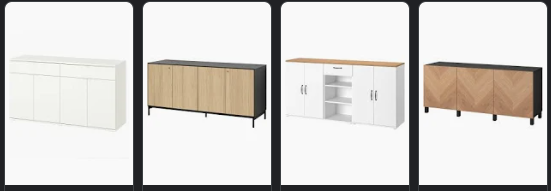
Kitchen sideboards, also known as buffets, provide not only functionality but also elegance and charm to any kitchen setting.
Traditionally, these multifunctional pieces of furniture are used to store and display items. Depending on geographical location and cultural context, kitchen sideboards may be referred to as credenzas, buffets, or hutches. These terms may vary slightly in meaning but often serve similar purposes.
Typically placed in dining areas or kitchens, these cabinets offer extra storage and surface space. Their versatile design allows for the storage of dinnerware, utensils, and other kitchen essentials while providing a platform for serving food.
Ultimately, the term used to describe a kitchen sideboard may vary, but the functionality remains consistent. Whether one calls it a kitchen sideboard cabinet, a buffet, or a credenza, these essential pieces of furniture maintain their classic appeal, fusing practicality with timeless style. Such versatility ensures they continue to be valued additions to modern-day homes, supporting both practical and aesthetic functions.
Do people still use sideboards?
In a world where fashion evolves rapidly, certain timeless pieces of furniture continue to hold their place. The kitchen sideboard cabinet, with its multifaceted utility and elegant appeal, remains a staple in home décor.
Yes, sideboards are still prominent in contemporary homes.
Sideboards offer a perfect blend of functionality and style.
Often, modern sideboards are crafted with innovative designs and sustainable materials, enhancing their allure.
These cabinets provide extra storage space to minimize kitchen clutter while also serving as a stylish surface for display.
Clearly, sideboards' enduring charm is matched by their practicality. For those seeking both form and function, the kitchen sideboard cabinet remains an enduring choice.
What is the difference between a sideboard and a huntboard?
A sideboard and a huntboard, while similar in functionality, each possess unique characteristics that distinguish them from one another. Both pieces serve as valuable additions to dining and kitchen areas.
Sideboards are typically lower and broader than huntboards.
As their name suggests, sideboards traditionally line the side of a dining room.
They serve as a station for food and drink, providing ample storage.
Conversely, huntboards are taller and narrower, reflecting their origins as practical furniture for hunters.
The additional height of a huntboard accommodates standing guests, ideal for serving refreshments quickly. The distinction in height and design between these two pieces allows them to complement diverse interior designs.

